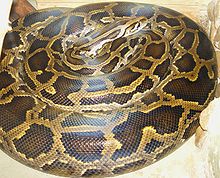Python (genus)
| Python | |
|---|---|
 |
|
| Burmese python, Python bivittatus | |
| Scientific classification | |
| Kingdom: | Animalia |
| Phylum: | Chordata |
| Class: | Reptilia |
| Order: | Squamata |
| Suborder: | Serpentes |
| Family: | Pythonidae |
| Genus: |
Python Daudin, 1803 |
| Species | |
|
See text |
|
| Synonyms | |
|
|
See text
Python, from the Greek word (πύθων/πύθωνας), is a genus of nonvenomous pythons found in Africa and Asia. Until recently, seven extant species were recognised; however, three subspecies have been promoted and a new species recognised. A member of this genus, P. reticulatus, is among the longest snake species and extant reptiles in the world.
In Africa, members of the genus are found in the tropics south of the Sahara, but not in the extreme south-western tip of southern Africa (Western Cape) or in Madagascar. In Asia, they are found from Bangladesh, Nepal, India, Pakistan, and Sri Lanka, including the Nicobar Islands, through Myanmar, east to Indochina, southern China, Hong Kong and Hainan, as well as in the Malayan region of Indonesia and the Philippines.
Some suggest that P. molurus and P. sebae have the potential to be problematic invasive species in South Florida. The United States Department of Agriculture reports that only Python molurus bivittatus is an invasive species in the United States. In early 2016, after a culling operation yielded 106 of the animals, Everglades park officials suggested that "thousands" may live within the park, and that the species has been breeding there for some years. More recent data suggest that these pythons would not withstand winter climates north of Florida, contradicting previous research suggesting a more significant geographic potential range.
...
Wikipedia
